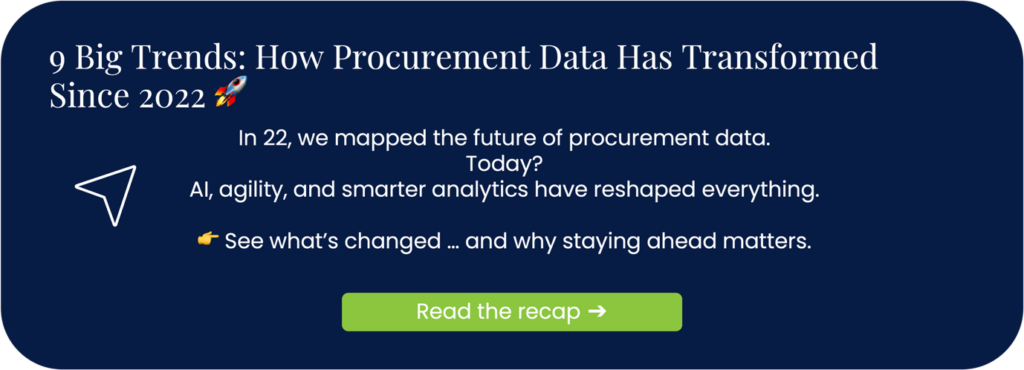
“It always starts the same way”, said a Procurement Analyst I interviewed for a role with our team here at Purchasing Index.
She said, “A cheery email, a calendar invite labelled “Quick Spend Review,” and a promise that the data “should be mostly clean.” I sit down, open the file — and immediately feel my soul leave my body. There it is: ‘Miscellaneous’ making up half the spend, supplier names merged like a bad dating app, six currencies jumbled in one cell, and a “dashboard request” needed… yesterday.”
At this point, any procurement data analyst knows the drill: smile, nod, and quietly begin the Herculean task of fixing what shouldn’t be broken in the first place.
But behind the polite smiles and “no problem!” emails, they’re secretly screaming inside. Because these issues aren’t one-offs — they’re patterns. Patterns that cost organisations money, waste time, and kill the strategic potential buried in their data.
That’s why we’re here: to pull back the curtain a little.
This is the side of procurement data analysis you rarely hear — the nine things procurement data analysts are too polite to tell you.
Note: the opinions expressed here aren’t necessarily those of Purhcasing Index (PI Data Analytics) itself. Instead, they’re a reflection of the real-world frustrations and lessons we hear every day from procurement data analysts working deep inside organisations across Australia and beyond.
Consider this a darkly humorous, slightly exasperated love letter to better spend categorisation techniques, cleaner supplier segmentation, and the dream of dashboards that don’t cause existential dread.
1. “You skipped taxonomy review. Again.”
What Happens When You Skip Procurement Taxonomy Reviews?
Look, I get it — reviewing your category taxonomy isn’t exactly thrilling. But if your spend data classification still runs on a category tree older than your procurement platform, we have a problem. A big one. Without updated taxonomies, even the most sophisticated indirect procurement strategies are flying blind.
Taxonomies aren’t just nice-to-have admin. They are the spine of accurate spend analysis. When you skip reviewing and refreshing them, outdated or irrelevant categories creep in. Emerging spend areas (hello, digital services) get dumped into ‘Miscellaneous’, and critical supplier shifts go unnoticed. The result? Flawed ABC analysis in procurement, poor prioritisation, and missed savings opportunities.
Review your procurement taxonomy at least once a year. Your spend evolves — your category structure should too.
When your spend categories don’t reflect how your organisation actually buys today, any insights you pull are basically fiction. And if you’re still basing strategic decisions on them? You’re building castles on sand.
Spend data classification needs regular maintenance — just like any asset you expect to perform. So please, for the love of clean data, schedule a taxonomy review. Future You (and your procurement data analyst) will thank you.
2. “Just because two suppliers have similar names doesn’t mean they’re the same.”
How Similar Supplier Names Wreck Procurement Data Accuracy
Here’s a friendly PSA from your procurement data analyst: just because two suppliers sound similar doesn’t mean they are the same. ‘Staples Australia Pty Ltd’ is not the same as ‘Staples AU’ or — heaven help us — ‘OfficeSupplies123’. Manually merging supplier names without verifying entity details is the fastest way to torch the integrity of your procurement data analytics.
We understand the temptation. It looks tidy. It feels efficient. But procurement data analysts rely on clean, accurate supplier records to produce meaningful insights. When you assume instead of checking, you’re inviting double-counting, compliance risks, and missed opportunities for proper supplier performance evaluation. Worse, it sabotages spend consolidation strategies because you’re merging apples, oranges, and maybe the odd office chair.
Always match suppliers by entity IDs or ABNs, not just by name. Names lie. Legal entities don’t.
Good procurement data analytics is built on precision. We don’t just eyeball supplier names — we match ABNs, check corporate structures, and validate transaction histories. So next time you’re tempted to manually ‘tidy’ supplier data, resist the urge. Let the people who love a forensic audit of your vendor master file (yes, us) handle it properly.
3. “Excel is not a database. Please. Stop.”
Why Excel Isn’t Enough for Serious Procurement Spend Analysis
I say this with love: Excel is not a database. If your entire spend data analysis process starts and ends with a maze of VLOOKUPs, colour-coded cells, and a prayer, you’re not doing procurement spend analysis — you’re time-travelling back to 2009.
Sure, Excel has its place. It’s great for quick checks, small pivots, and the occasional panic report at 4:59 PM. But when you’re handling millions in supplier spend, it simply can’t cope. Data integrity breaks down. Version control turns into a horror movie. And don’t even get me started on those ‘accidental’ cell overwrites that quietly wreck your totals.
Spend data analysis needs systems that are purpose-built: proper databases, spend cubes, ETL pipelines, and procurement analytics platforms that treat your information like the valuable asset it is. Without that backbone, insights are shaky, errors creep in, and trust — mine and yours — evaporates.
If your spend analysis relies on manual VLOOKUPs, your risk of critical error is huge — and growing with every edit.
I’m not asking for miracles. Just… let’s give your procurement spend analysis the tools it deserves. And let poor Excel retire gracefully to what it does best: quick math, personal budgets, and slightly aggressive to-do lists.
4. “Your ‘miscellaneous’ category is giving me hives.”
Why Poor Spend Categorisation is Hurting Your Procurement Analysis
Look, I get it — not everything fits neatly into a box. But when half your supplier spend is dumped into ‘Miscellaneous’ or ‘Other’, it’s not a clever workaround. It’s a cry for help. Without proper spend categorisation techniques, your data isn’t just messy — it’s unusable. I can’t analyse noise. I can’t segment supplier spend when your biggest ‘vendor’ appears to be a black hole of random transactions.
Spend data is meant to tell a story. It’s supposed to reveal patterns, highlight risks, spotlight opportunities. Instead, I’m stuck decoding chaos, trying to pull insights from a landfill of “Other.” Bad categorisation doesn’t just make my job harder — it cripples procurement strategy. You can’t consolidate suppliers you can’t identify. You can’t negotiate volume discounts on spend you haven’t segmented.
“Miscellaneous” isn’t a category — it’s a warning sign. Every dollar hidden there is a lost insight and a missed opportunity.
Investing a little effort upfront to properly classify spend data unlocks real strategic value. Smart spend categorisation techniques and meaningful supplier segmentation are what turn good procurement into great procurement. Trust me: ‘Miscellaneous’ is not a growth strategy.
5. “You want visuals, but you gave me garbage.”
Why Dirty Data Kills Procurement Dashboards Before They Launch
You asked for slick procurement dashboards — clean lines, smart insights, maybe even a few jazzy graphs to wow the exec team. I wanted that too. But here’s the thing: procurement data analysis follows one brutal rule — dirty in, dirty out.
If your raw data shows duplicate suppliers, blank fields, random typos, and (why, oh why) six different currencies crammed into the same cell, no dashboard in the world can save it. What you’ll get isn’t visual storytelling; it’s visual chaos with a fancy colour palette.
Procurement dashboards aren’t magic wands. They’re amplifiers. If the input is clean, they surface brilliant opportunities for consolidation, risk management, and savings. If the input is garbage, they just make the chaos more colourful — and more visible to senior leadership.
Garbage in = garbage visuals. Clean data is the secret ingredient behind every dashboard that actually drives decisions.
So if you dream of procurement dashboards that actually mean something, start by cleaning the basics. Validate supplier records. Standardise data fields. Sanity-check currency formats. Because when procurement data analysis has good ingredients to work with, we can actually serve up something worth showing off.
6. “No, I can’t make this look good for the board if you gave it to me 30 minutes ago.”
Why Procurement Data Storytelling Takes More Than 30 Minutes
Contrary to popular belief, procurement data storytelling is not an act of sorcery. I can’t wave a magic wand and turn a scrappy dataset into a boardroom-ready strategic narrative in 30 minutes. Good storytelling — the kind that shapes decisions, drives investment, and actually impresses the exec team — takes time.
When you drop last-minute requests on procurement data analysts, what you’re really asking for is surface-level noise. You won’t get deep insights, clear trends, or a compelling story arc. You’ll get rushed charts, patchy logic, and probably a mild existential crisis (mine, not yours).
Strategic procurement deserves better. Procurement data storytelling is about weaving clean data into a clear, confident message: here’s what’s happening, why it matters, and what we should do next. That kind of clarity doesn’t happen on a tight lunch break.
Start with the story, not the charts. Clear narratives need time — don’t expect magic in 30 minutes.
If it’s important enough for the board to see, it’s important enough to plan for. Give us a little runway. We’ll give you data stories that don’t just look good — they drive real action.

7. “I cleaned this data last month. You broke it again.”
How Untracked Changes to Supplier Data Destroy Spend Analysis
There’s a special kind of heartbreak that only procurement data analysts know: spending days cleaning a supplier master or perfecting spend categorisation… only to watch it unravel within weeks. Every time someone updates the supplier records, reclassifies spend, or “quickly tweaks” categories without flagging it, we lose hours redoing what was already fixed.
Spend analysis best practices aren’t just about initial cleanup — they’re about protecting that hard-won data quality over time. When changes happen in isolation, without governance or communication, small errors multiply fast. Duplicate suppliers creep back in. Categories misalign. Fields go blank. Before you know it, the shiny, trusted data set becomes another tangled mess.
Making ‘small’ changes to supplier data without telling your analyst breaks historical spend trends and corrupts dashboards.
Procurement data analysts thrive on stability and transparency. We don’t mind changes — change is necessary — but we need it controlled, communicated, and logged properly. Otherwise, we’re stuck in a perpetual loop of “Groundhog Day,” fixing the same problems month after month.
Data quality isn’t a one-time project. It’s an ongoing commitment. Respect the clean-up effort, follow spend analysis best practices, and your procurement function will run smarter, faster, and with way fewer passive-aggressive emails from us.
8. “Stop asking for tail spend insights if you won’t give us full PO data.”
Can You Really Analyse Tail Spend Without Full PO Data?
Everyone loves the idea of unlocking hidden savings in tail spend — until it’s time to actually hand over the data. You want brilliant insights into the long tail of suppliers, but what you give us is… partial files, vague summaries, and PDFs from a decade ago. I’m good — but I’m not clairvoyant.
Tail spend analysis depends on full, structured purchase order (PO) data. Without it, we’re trying to piece together a 1,000-piece puzzle with half the pieces missing and no picture on the box. Procurement data analysts can do a lot with limited resources, but pulling strategic insights from fragments isn’t analysis — it’s guesswork.
When PO data is incomplete or locked away in unstructured formats, you’re tying our hands. You won’t get accurate supplier consolidation opportunities, contract leakage identification, or proper risk profiling. You’ll get a lot of “It depends” and “We need more data.”
If you’re serious about taming the tail, invest in capturing and sharing full PO data.
Tail spend isn’t mysterious. It’s just badly lit — and we can turn the lights on if you actually hand us the keys.
9. “We can do so much more – if you just let us in earlier.”
Why Procurement Analysts Should Be Involved in Strategy Early
Imagine what procurement spend analysis could achieve if analysts weren’t just the clean-up crew called in at the eleventh hour. We’re not reporting robots — we’re problem-solvers, strategists, and pattern-spotters. But to unlock that value, you have to let us into the spend analysis process before everything is on fire.
When procurement data analysts are brought in early, we can spot trends as they emerge, flag risks before they become front-page problems, and uncover strategic opportunities that aren’t visible once decisions are already made. Waiting until after the contracts are signed or the budgets are spent reduces our role to damage control — and it’s a massive waste of potential.
Real procurement spend analysis isn’t reactive; it’s proactive. It’s about helping you anticipate supplier risks, identify innovation opportunities, and sharpen negotiation strategies. But we can’t do that if we’re only called in when someone needs a last-minute dashboard.
Bring analysts into planning, not just reporting. Early insights = smarter sourcing, stronger negotiations, and better outcomes.
So trust us with more than just cleanup. Loop us into the conversation at the start — when you’re planning, sourcing, strategising. You’ll get sharper insights, smarter decisions, and way fewer painful surprises.
So there you have it — the things Procurement Data Analysts think, but are usually too polite (or too caffeinated) to say out loud.
Procurement data analysis isn’t magic. It’s not even about flashy tools or trend-chasing dashboards. It’s about strong fundamentals: clean data, structured processes, and treating analysts like strategic partners instead of last-minute fixers.
When you invest in better spend categorisation, consistent taxonomy updates, full PO data, and — above all — early engagement with your data team, the results speak for themselves. Sharper insights. Smarter decisions. Procurement strategies that actually stick.
Behind every successful procurement transformation is a data analyst who wasn’t treated like a janitor.
Bring us in early. Give us clean inputs. Trust the process.
You’ll get more than just reports — you’ll get competitive advantage.
And if nothing else: next time you see a ‘Miscellaneous’ category the size of a small country, spare a thought for your friendly procurement data analyst quietly dying inside.
How Purchasing Index Solves These 9 Procurement Data Headaches
✅ State-of-the-art technology:
Our platform rivals the best, using AI, machine learning, and powerful algorithms to automate spend classification — aligned to your taxonomy, UNSPSC standards, or customised frameworks.
✅ Real, human intelligence:
Behind the tech, you have a full team of dedicated procurement data analysts working around the clock — validating, enriching, and enhancing your data so insights are not just faster, but smarter.
✅ Continuous improvement:
Spend data evolves. So does our solution. We don’t just clean once; we maintain data quality, adapt to category changes, and ensure every report, dashboard, and insight reflects the latest and best picture.
✅ Strategic alignment:
Our focus isn’t just reporting. It’s empowering procurement teams with meaningful, actionable insights that drive supplier strategies, category management, and executive decision-making.
Better data. Smarter decisions. Real results.
That’s the PI difference.
Want better dashboards, sharper insights, and procurement strategies that actually stick?
Trust us: it’ll save you time, money, and a lot of awkward dashboards.
Get Procurement Insights That Matter
Join 10,000+ procurement professionals getting monthly expert cost-optimisation strategies and exclusive resources. Unsubscribe anytime.
Join








